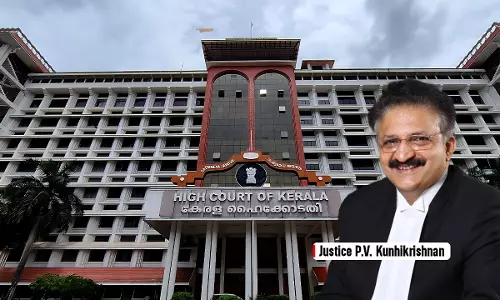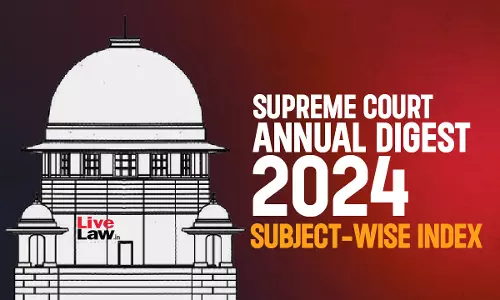Amalgamation Doesn't Wind Up Company; Income Tax Notice Not Invalid Merely Because It Was Sent To Amalgamating Company : Supreme Court

The Supreme Court, on Tuesday, held that whether corporate death of amalgamating entity upon amalgamation per se invalidates an assessment order issued under the Income Tax Act, 1961 cannot be determined on a bare application of Section 481 of the Companies Act, 1956 or its equivalent in the 2013 Act, which deals with the dissolution of the said company. The Apex Court stated that the...
The Supreme Court, on Tuesday, held that whether corporate death of amalgamating entity upon amalgamation per se invalidates an assessment order issued under the Income Tax Act, 1961 cannot be determined on a bare application of Section 481 of the Companies Act, 1956 or its equivalent in the 2013 Act, which deals with the dissolution of the said company. The Apex Court stated that the same would depend on the terms of the amalgamation and the facts of each case.
A Bench comprising Justices U.U. Lalit and S. Ravindra Bhat allowed a plea assailing the order of the Delhi High Court affirming the order of the Income Tax Tribunal, which quashed the assessment order at the threshold without going into the merits of the matter. While allowing the appeal, the Bench restored the matter before the ITAT for determination on merits(Principal Commissioner of Income Tax (Central) - 2 v. M/s. Mahagun Realtors (P) Ltd..
Factual Background
Mahagun Realtors Pvt. Ltd. ("MRPL") was engaged in development of real estate. By an order of the High Court dated 10.09.2007, MRPL amalgamated with Mahagun India Pvt. Ltd. ("MIPL") with effect from 01.04.2006. In survey proceedings conducted on 20.03.2007 some discrepancies were noticed and consequently a search and seizure operation was carried out on 27.08.2008. Statements of the common directors of the companies were recorded under the provision of Income Tax Act, 1961 ("Act"), wherein they conceded that true income of the entities were not reflected. On 02.03.2009, the revenue issued notice to the assessee to file Return of Income for the year 2006-2007 under Section 153A of the Act within a period of 16 days. As MRPL failed to do so, it was issued a show cause notice under Section 276CC of the Act. MRPL assured to file the return by 30.06.2009. It was eventually filed on 28.05.2010 with the particulars of MRPL. The assessment order issued on 11.08.2011 showed the assessee as "Mahagun Realtors Private Ltd, represented by Mahagun India Private Ltd". It was challenged before the Commissioner of Income Tax and partly set aside. The appeal preferred by the revenue before the ITAT was rejected and MRPL's cross objection was allowed solely on the ground that at the time of assessment order the MRPL did not exist as it had already amalgamated with MIPL. Relying on the judgment of the Apex Court in Principal Commissioner of Income Tax v. Maruti Suzuki India Limited 2019 SCC OnLine SC 928, the High Court had dismissed the appeal filed by revenue.
Contentions raised by the appellant
Additional Solicitor General, Mr. N. Venkataraman, appearing on behalf of the revenue submitted that the assessment order named both MRPL and MIPL. It was averred that when the assessment, in substance, is in conformity with the law, minor defects can be cured under Section 292B of the Act. He attempted to distinguish the facts of the present matter from that of Maruti Suzuki (supra). It was submitted that unlike the instant case, in Maruti Suzuki the revenue was aware of the amalgamation and yet passed the order in the name of the amalgamating company.
Contention raised by the respondent
Advocate, Ms. Kavita Jha, appearing on behalf of the MRPL argued that upon sanction of amalgamation scheme, MRPL stood dissolved in terms of Section 394 of the Companies Act, 1956. It was contended that amalgamating company, MRPL, could not have been considered as a 'person' under Section 2(31) of the Act. She averred that the assessment order issued against a non-existing entity was void-ab-initio. Citing Spice Infotainment Limited v. Commissioner of Income Tax (2012) 247 CTR 500 (Del), it was argued that assessment framed in the name of amalgamating company which is non-existent is invalid and such defects cannot be cured in terms of Section 292B, as suggested by the ASG.
Analysis of the Supreme Court
The Court noted that amalgamation is different from winding up, in the sense that though the outer shell of the corporate entity is destroyed, the corporate venture continues. Upon amalgamation, the cause of action does not per se cease.
Referring to Commissioner of Income Tax v. Hukamchand Mohanlal 1972 (1) SCR 786, the Court stated that when the predecessor dies the liability to pay their tax falls on their legal representatives. Referring to a catena of judgment and provisions of the Income Tax Act, the Court was of the view that the method of treatment of amalgamation was particularly indicated by the Act. On perusal of the same, the Court observed that the rights, assets and liabilities of the amalgamating company do not cease and that there are provisions of deeming fiction whereby the amalgamated company is deemed to carry the enterprise of the amalgamating entity. Citing Bhagwan Dass Chopra v. United Bank of India (1998) 1 SCR 1088 and Singer India Ltd. v. Chander Mohan Chadha (2004) Supp (3) SCR 535, the Court noted that in case of amalgamation, the rights and liabilities of one company is transferred to another and therefore the successor is entitled to liabilities and assets of the amalgamating company, in terms of the contract of transfer. It was of the view -
"The combined effect, therefore, of Section 394 (2) of the Companies Act, 1956, Section 2 (1A) and various other provisions of the Income Tax Act, is that despite amalgamation, the business, enterprise and undertaking of the transferee or amalgamated company- which ceases to exist, after amalgamation, is treated as a continuing one, and any benefits, by way of carry forward of losses (of the transferor company), depreciation, etc., are allowed to the transferee. Therefore, unlike a winding up, there is no end to the enterprise, with the entity. The enterprise in the case of amalgamation, continues."
Referring to the terms of amalgamation, the Court noted that there was a clause which provided that MRPL's liability will devolve in MIPL. Moreover, the return filed by MRPL suppressed the fact about amalgamation. Appeals before the CIT and the ITAT was filed in the name of MRPL, and from its conduct the Court determined that MRPL consistently held itself to be the assessee. Though the assessment order referred to MRPL it stated that the same is represented by MIPL. The Court held that the assessment order was issued in consonance with law -
"The approach and order of the AO is, in this court's opinion in consonance with the decision in Marshall & Sons (supra), which had held that:
an assessment can always be made and is supposed to be made on the Transferee Company taking into account the income of both the Transferor and Transferee Company."
Case Name: Principal Commissioner of Income Tax (Central) - 2 v. M/s. Mahagun Realtors (P) Ltd.
Citation: 2022 LiveLaw (SC) 346
Case No. and Date: Special Leave Petition (C) No. 4063 of 2020 | 05 April 2022
Corum: Justices U.U. Lalit and S. Ravindra Bhat
Headnotes
Companies Act 1956 & 2013 - Amalgamation, thus, is unlike the winding up of a corporate entity. In the case of amalgamation, the outer shell of the corporate entity is undoubtedly destroyed; it ceases to exist. Yet, in every other sense of the term, the corporate venture continues – enfolded within the new or the existing transferee entity. In other words, the business and the adventure lives on but within a new corporate residence, i.e., the transferee company. It is, therefore, essential to look beyond the mere concept of destruction of corporate entity which brings to an end or terminates any assessment proceedings. There are analogies in civil law and procedure where upon amalgamation, the cause of action or the complaint does not per se cease – depending of course, upon the structure and objective of enactment. Broadly, the quest of legal systems and courts has been to locate if a successor or representative exists in relation to the particular cause or action, upon whom the assets might have devolved or upon whom the liability in the event it is adjudicated, would fall(Para 18).
Income Tax Act, 1961 - The combined effect, therefore, of Section 394 (2) of the Companies Act, 1956, Section 2 (1A) and various other provisions of the Income Tax Act, is that despite amalgamation, the business, enterprise and undertaking of the transferee or amalgamated company as a continuing one, and any benefits, by way of carry forward of losses (of the transferor company), depreciation, etc., are allowed to the transferee. Therefore, unlike a winding up, there is no end to the enterprise, with the entity. The enterprise in the case of amalgamation, continues(Para 30).
Click Here To Read/Download Judgment




